-
1. Introduction
-
1. Start
2. Target group
3. Learning objectives
4. Course length
5. Learning objectives test
6. Responsibility and consequences
7. Scope of the Code of Practice (CoP)
8. What is a Cargo Transport Unit (CTU)?
9. What is a load unit and what are the requirements?
10. Combined transport
11. Roles and responsibilities
12. Roles, responsibilities and laws
13. Exercise
-
2. Basic requirements
-
1. Start
2. Introduction
3. Stopovers and loads for "worldwide" transport
4. Basic preparation/General obligations
5. Duties of packers
6. Planning
7. Packing - general
8. Packing - Orders
9. Packing dangerous goods
10. Securing the load
11. After packing
12. Unpacking or unloading the CTU
13. Exercise
-
3. Responsibility and liability
-
4. Loads for land and sea transport
-
1. Start
2. Introduction
3. Average wave height at sea
4. Transport loads for sea transport
5. Why does inadequate load securing not always lead to damage?
6. Transport loads for road transport
7. Transport loads for rail transport
8. Handling load - Container bridge
9. Handling load - Van Carrier
10. Exercise
-
5. Characteristics of carriage of goods units
-
1. Start
2. Introduction
3. Information for senders and packers
4. Definition of container (ISO 668)
5. Container: strength and load
6. Container: markings
7. Container: ventilation openings
8. Container: lashing point
9. Container: lashing strap strength
10. Container: load distribution and line loads
11. Container: the line load is too high, what can be done?
12. Container: loads on container floors
13. Loads for vehicle structures
14. Vehicle: marking the structure
15. Traction and form fit
16. Calculation of the stability of the vehicle structure, example 1
17. Calculation of the stability of the vehicle structure, example 2
18. Calculation: stability of the vehicle structure/load securing
19. Calculation of the stability of the vehicle structure, example 3
20. Calculator: determine the number of straps
21. Swap body
22. Exercise
-
6. Inspection of CTUs
-
7. Training
-
8. Learning objectives test
-
9. Further information
Container plate
According to the "International Convention for Safe Containers", each authorised container must bear a safety approval plate (CSC).
The minimum size of this plate isl 200 mm x 100 mm. The required information must be presented in English or French as a minimum
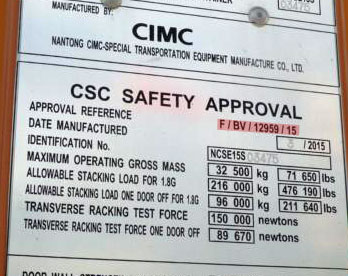
- Registration country, registration name
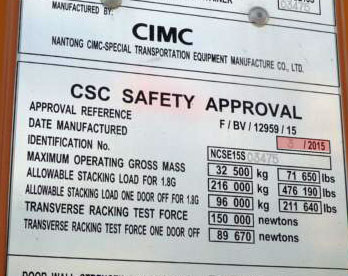
- Registration country, registration name
- Date of manufacture (month and year)
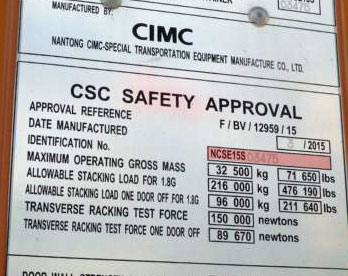
- Registration country, registration name
- Date of manufacture (month and year)
- Manufacturer identification number
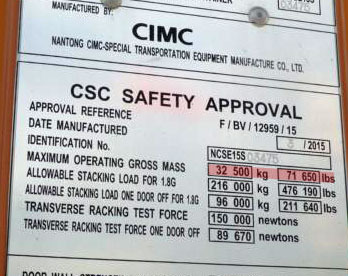
- Registration country, registration name
- Date of manufacture (month and year)
- Manufacturer identification number
- Maximum gross weight
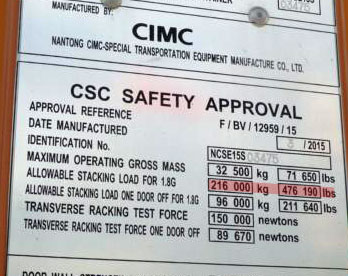
- Registration country, registration name
- Date of manufacture (month and year)
- Manufacturer identification number
- Maximum gross weight
- Permitted stacking weight at 1.8 g
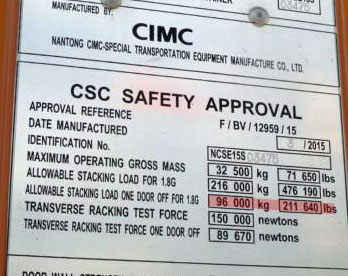
- Registration country, registration name
- Date of manufacture (month and year)
- Manufacturer identification number
- Maximum gross weight
- Permitted stacking weight at 1.8 g
- Permitted stacking weight in case of an open doorat 1.8 g


